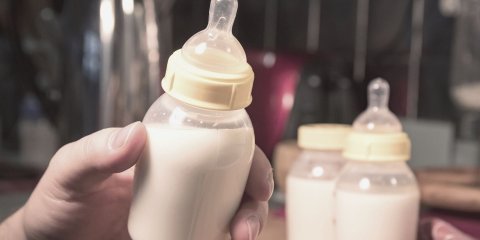Key Points
- Formulas are age specific, generally catering for three stages: infants from birth, infants from six months old and for toddlers from 12 months old.
- Infant formula meets the nutritional needs of infants, whereas toddler formula does not meet the nutritional needs of toddlers.
- Infant formula used age-appropriately does not interfere with learning good eating habits, but toddler formula can interfere with learning good eating habits.
- Infant formula can’t be promoted in Australia, but toddler formula can.
There’s so much to learn when you’re a new parent. And feeding is certainly high on the agenda in those early years.
For parents who aren’t breastfeeding or are mixed feeding, understanding infant formula is a must. Finding formula (and bottles for that matter) that work for your baby doesn’t always happen overnight. And before you know it, you’re looking at the tins of toddler formula on the supermarket shelf, wondering if you need to buy it.
That’s why we’ve written this article. To help you understand the differences between toddler formula vs infant formula so you can make an informed choice for your child about giving them toddler formula.
Formula stages: understanding the basics
Formulas are age-specific . This is for good reason. As our little ones age, their nutritional requirements change.
In Australia, we are used to seeing Stage 1 (from birth), Stage 2 (from 6 months) and Stage 3 (12 months+). Some brands even offer Stage 4 (from 3 years). The four stages of formula can also be referred to as Infant, Follow on, Toddler and Junior. Stage 3 and 4 formulas are not designed or regulated for infant use .
The question is - do formulas do a good job of accommodating those changing needs, particularly as infants become toddlers? Let’s look at the nutritional composition of toddler formula vs infant formula first.
1 - Nutritional composition
It can be hard to tell toddler formula vs infant formula apart on the supermarket shelf, but they do have distinct differences when it comes to their makeup.
Nutrition-wise, “ formulas can be classified according to three basic criteria: caloric density, carbohydrate source, and protein composition.”
Infant formula is modeled after breast milk , attempting to mimic its nutritional composition . With lactose as its carbohydrate source, it provides 20 kcal per ounce.
Toddler formula is different because it is not a complete substitute for the nutritional requirements of toddlers . Rather, it is designed as a product to “ fill the gaps in your toddler’s diet ” according to marketing anyway. In other words, it’s “insurance” for picky eaters.

But, according to Sydney GP Dr James Best, if children are eating well, these gaps in their diet don’t exist . So even if toddler “ milk-based formulas contain added iron , vitamin C, vitamin E, and zinc”, these aren’t needed if they are eating appropriately for their age.
It’s a bit of a catch-22, because giving toddler formulas to healthy children in the first place, could be holding them back from eating well - which we’ll discuss in point two of this article.
Most children are capable of drinking cows milk from 12 months of age. If you’re wondering whether toddler formulas are better for their development than whole cow’s milk, there’s no evidence of this . Not to mention that toddler formula is also a more expensive alternative than cow’s milk.
Jennifer Pomeranz, a public health researcher at New York University, spoke to NPR about her research into toddler milk labelling and composition. She found that when looking at toddler formula vs infant formula, there were some ingredients in common, but toddler milk often contains more sodium, sugars and fats , and are therefore, less nutritious. Foods higher in salts, sugars and fats (when they replace nutritious foods) can place toddlers at risk of tooth decay, low iron, obesity and even cause sleep disruption .
Nutritionally speaking, only in extreme circumstances is toddler formula required and these are related to when a toddler cannot eat normally. Turning to toddler formulas under these circumstances should be under the advice of your GP.
2 - Eating habits
“There's plenty of science showing that what kids eat in their first few years lays a foundation for their physical growth and brain development for the rest of their lives.” This makes eating habits an extremely important component of home life.
Parents often have some anxiety over feeding their children. As well as “are they a good sleeper?” parents are commonly asked, “do they eat well?”.

When your little one is an infant, this anxiety is usually a little more simple - it’s mostly about the quantity of breastmilk or infant formula they are taking in. But when your infant becomes a toddler and is therefore reliant on solid foods, the anxiety about eating habits often goes up a notch, because it’s not just about quantity, but a whole array of things.
So, when we’re talking about toddler formula vs infant formula, there’s a significant difference in how they tie in with eating habits.
Infant formula is a necessary replacement for breastfeeding. When used up to 12 months of age it does not interfere with developing eating habits .
Toddler milk can prevent learning healthy eating habits . When toddlers are given the opportunity to eat real food, they are able to develop an appreciation for tastes and textures of foods, as well as understanding appropriate mealtime behaviours.
Giving your toddler bottles of toddler formula instead of some meals, means they have less opportunity, and may struggle to develop healthy eating habits.
There is so much for a toddler to learn when it comes to eating. For example:
- How to listen to their appetite
- That it’s ok to refuse food if they aren’t hungry
- How to participate in a family meal
- How to make healthy choices
- Understanding when the next meal will be when you have a set routine
Even something as simple as learning to eat with a spoon might be delayed, if the opportunity just isn’t there. It’s even thought that the makeup of commercial toddler milks can lead to unhealthy taste preferences .
So, rather than worrying about giving toddlers formula to allay anxieties over nutrition, parents’ efforts are better spent fostering healthy eating.
3 - Marketing in Australia of Infant Formula (MAIF) Agreement
In 1981, the World Health Organisation (WHO) set out an International Code of Marketing of Breast-milk Substitutes . By removing the influence of marketing, the aim is to protect and increase breastfeeding rates which had previously seen a significant decline.
In response to the WHO Code, Australia developed the Marketing in Australia of Infant Formula (MAIF) Agreement . The agreement is a voluntary, self-regulatory code of conduct that “protects and promotes breastfeeding and by ensuring the proper use of breast milk substitutes, when they are, on the basis of adequate information through appropriate marketing and distribution.”
In 2016, the ACCC granted a re-authorisation of the MAIF agreement for a period of 5 years. What this means is, infant formula (designed for babies under 12 months) can’t be promoted or advertised directly to the Australian public .
This is an important point when discussing toddler formula vs infant formula. While infant formula can’t be advertised in Australia, toddler formula can .
And the sales of toddler formulas and other milk-based drinks for older infants are proof that the marketing really does work. Worldwide, toddler milk sales increased by 53% from 2008 to 2013 . That’s an incredible increase over just five years. And WHO found that there is 8.6% growth each year on toddler milk sales (the fastest increase in categories of breastmilk substitutes).
... the diets of most US infants (up to 12 mo) and toddlers (12–36 mo) do not conform to expert recommendations
US research on marketing tactics used, found one of the top three problematic practices to be : “promotion of formula products (including specialty formulas and toddler milks) that are not necessary for most babies and toddlers, more expensive than recommended milk based products (ie, regular infant formula and plain milk), and potentially harmful to young children’s diets.”
An interesting perspective on this is that the production of toddler formulas has “created a fake feeding period that they filled with this new product. We're adding in now another few years of processed food consumption that didn't previously exist.”
In decades past, infants (who weren’t breastfed) transitioned from formula into a diet of solid foods and cow's milk soon after turning one.
Now, there is a new range of products on the market that lead parents to believe there’s a whole new stage when it comes to feeding their toddlers. It complicates the feeding process, makes the endeavour more expensive, but most significantly, it reduces the amount of whole, healthy foods our toddlers are eating.
Final thoughts on toddler formula vs infant formula
Infant formulas exist for a very good reason - as a complete nutritional substitute when breastfeeding isn’t possible.
On the other hand, toddler formulas aren’t a nutritional requirement for the healthy growth and development of our little ones.
When we are shown a display on supermarket shelves from Stages 1 through 3 (or 4), it’s easy to assume that’s the natural progression to follow. But, from age one, most children can drink cow’s milk and eat a varied diet with no need to be “supplemented” or “insured” by these toddler-specific formulas that play on the anxieties of parents.

